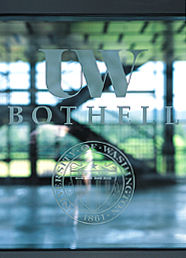Prelude
Closed Doors, Open Possibilities
Once upon a time, the Washington Legislature had the vision to establish a new university campus to meet the needs of its growing population. Unfortunately, there was considerable political "wheeling and dealing" over the location, but finally a site was chosen and a year later that campus opened its doors for the first time.

The UW seal marks the entryway to the new UW Bothell campus. Photo by Mary Levin.
But that first year was a disappointment. The enrollment numbers were far below what educators had projected, despite heroic recruiting efforts. Things got so bad during the second year that the university closed its doors in the middle of the second semester. It reopened that fall, only to close its doors four years later and remain closed for two years.
In the next decade that campus closed two more times and was threatened with an additional closure, but it was saved at the last moment. A new industry was transforming the state's economy, and a powerful CEO made a generous donation to keep the campus afloat. While it survived the economic crisis, problems rose over the site of our beleaguered campus. There came more political maneuvering before the fledgling university finally left its original home for a new, permanent site.
If you know anything about the history of the University of Washington Bothell, you might think I am describing the early years of that campus. After 10 years in temporary quarters, this month UWB is finally moving to its permanent campus, located on a former farm northeast of Seattle.
My history is about the UW, but not the UWB. It is the story of the first 35 years of the University of Washington in Seattle. Few alumni know that when the UW opened its doors in 1861, its college-level enrollment came to the surprising number of "one." The other 29 students were at the grammar school or high school level. This was after the UW's first president, Asa Mercer, had traveled 400 miles, visiting logging camps up and down Puget Sound to recruit students.
As for actual campus closures, a powerful state senator failed in his attempt to close down UWB in 1991. Compare that threat to Seattle's history: the doors were shut in 1863, 1867, 1874 and 1876. In 1873 Gov. Elisha Ferry wrote, "It can hardly be said that we have a University except in name." The UW would have shut down again in 1882 except that the president of the Northern Pacific Railroad, Henry Villard, made a $4,000 gift to keep the UW running.
Just as lawmakers near the turn of our century battled over the location of the permanent UWB campus, the Seattle campus site was under debate in the late 19th century. The original downtown site had outgrown its boundaries, and there were proposals to locate the campus in Jefferson Park or at Fort Lawton in Magnolia. It was only on the last day of the 1893 legislative session that Edmond Meany was able to slip in a bill to buy the 583-acre campus in Montlake.
No matter what century you are living in, giving birth to a university is a difficult task. Facing weak enrollments, political interference and a hot debate over location, visionaries like Clarence Bagley and Edmond Meany triumphed in the founding of the University of Washington. If they were alive today, they would be humbled to see not only prominent campus buildings named in their honor, but one of the premier research universities in the nation and the world.
The promise of UW Bothell—and it sister campus, UW Tacoma—is just as bright. UWB Chancellor Warren Buck likes to tell everyone that UCLA was once a "branch campus" of Cal-Berkeley. One hundred years from now, we too would be astonished at the transformation of these campuses. While time travel isn't possible, in this issue we celebrate the beginnings of that remarkable journey.
TOM GRIFFIN, Editor
|
 THE UNIVERSITY OF WASHINGTON ALUMNI MAGAZINE
THE UNIVERSITY OF WASHINGTON ALUMNI MAGAZINE
 THE UNIVERSITY OF WASHINGTON ALUMNI MAGAZINE
THE UNIVERSITY OF WASHINGTON ALUMNI MAGAZINE
